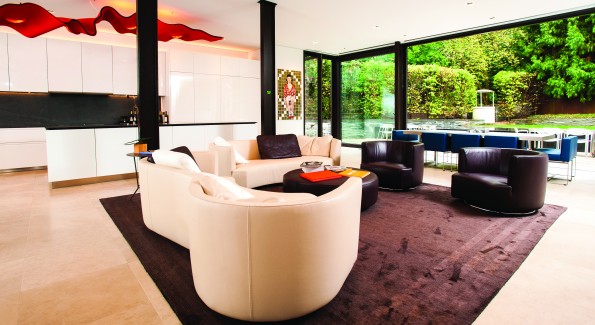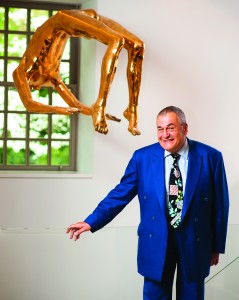Inside power lobbyist, philanthropist and contemporary art collector Tony Podesta’s Kalorama home.
By Laura Wainman

Podesta’s main design change for the house was to open up the floor plan and tear down the many compartmentalized rooms.The sliding glass windows were essential to give the house an indoor-outdoor atmosphere. The red sculpture over the kitchen was custom designed by German lighting designer Ingo Mauer and is a major focal point. (Photo by Joseph Allen)
If you’ve ever dreamed of strolling through a museum with a slice of pizza and glass of wine in hand, you need to befriend superlobbyist Tony Podesta. Known about town as a legendary political “fix-it” man, Podesta has turned his Kalorama home into a shrine to contemporary art, ranging from relatively under-the-radar artists such as Serbian painter Biljana Djurdjevic to those who are much better known (like French sculptor Louise Bourgeois).
The collection got a rather accidental start. After taking a 50 percent pay cut for his work during the last nine months of Ted Kennedy’s failed 1980 presidential campaign, Podesta ended up being handed a tube of artwork donated by major Kennedy-supporting artists of the day, such as Roy Liechenstein and Jasper Johns, in lieu of his foregone salary. He didn’t bother to open for five years, but when he did what he found were gems.
“I walked away with 10 or 12 pieces in that tube, including my first two Rauschenbergs and my first Warhol,” Podesta says.
Though his collection currently stands at 792 works (and rising as he still actively buys), only about 10 percent is displayed at any one time in the house, as Podesta prefers to rotate artwork annually. However, his first major purchase, a nearly-2,000-pound bronze sculpture by Bourgeois called “Arch of Hysteria,” is never taken down. Over the years he has donated more than 1,300 pieces to local museums, including the Corcoran, Hirshhorn, Katzen Center at American University, National Gallery of Art, National Portrait Gallery and the Phillips Collection; his largest donation stands at 505 pieces to the National Museum of Women in the Arts. In New York City, he has donated to the Museum of Modern art and the Whitney. Last year alone he gifted more than 200 works.

Tony Podesta with one of his favorite works, Louise Bourgeois’ “Arch of Hysteria” sculpture. (Photo by Joseph Allen)
“My plan for the collection is to donate it slowly over the course of my lifetime to museums and give the rest away after I pass,” Podesta says. “People who enjoy success should be giving back and sharing the gifts they have received. Most of my philanthropy occurs in the art world with my donations.”
He has dedicated himself solely to contemporary works — Bourgeois is one of only two deceased artists represented in the collection — and prefers to buy from the same artists once he establishes that he likes their work. Currently he has collected from 40 different artists in some depth, with his top five being Marina Abramovic, Vik Muniz, Bourgeois, Olafur Eliasson and Antony Gormley.
“My personal style aesthetic is spare and clean as the art was always intended to be the centerpiece of the house,” Podesta says.
Though he purchased the 7,000-square-foot residence in 2006, he was not able to move in until 2009 as it took nearly three years to finish the massive renovations he undertook, mainly to better accommodate his art.
“The house is in the historic district and situated across from Rock Creek Park, so it is subject both to the regulations of the historic and fine arts commissions,” Podesta says. “Basically that meant that the façade of the house could not change, but the interior style was more traditional and segmented than I envisioned, with a bunch of small rooms everywhere. I worked with an architect to tear the insides out completely. Essentially we rebuilt everything from scratch within the existing three walls of the old house, and made it much more open.”
Podesta is constantly on the move. The day we met he was dashing home from a Hillary Clinton fundraiser and preparing for an early-morning flight to his vacation home in Venice the following day. Not to mention the rapid-fire nature of his work as founder and chairman of The Podesta Group, whose client roster includes such high profile names as Blue Cross/Blue Shield, Wal-Mart, Wells Fargo and Lockheed Martin. Because of his busy schedule he needs his house to be a refuge from daily stress. While its open floor plan and rather sparse décor can give off a museum vibe, particularly in the basement where white-walled rooms are lined with glass containers of shelved art highlighted by recessed lighting, Podesta’s feelings towards his guests are far from cold or regimented. He regularly opens his house to casual pizza parties co-hosted by his friend James Alefantis, the owner of Comet Ping Pong. Over 200 pies emerge from the outdoor pizza oven as guests wander through the house and garden while studying his art collection.
Podesta knows what he likes, makes room for art in most every part of his life and wants to share it with those around him.
See the full story from the June 2015 issue below:




